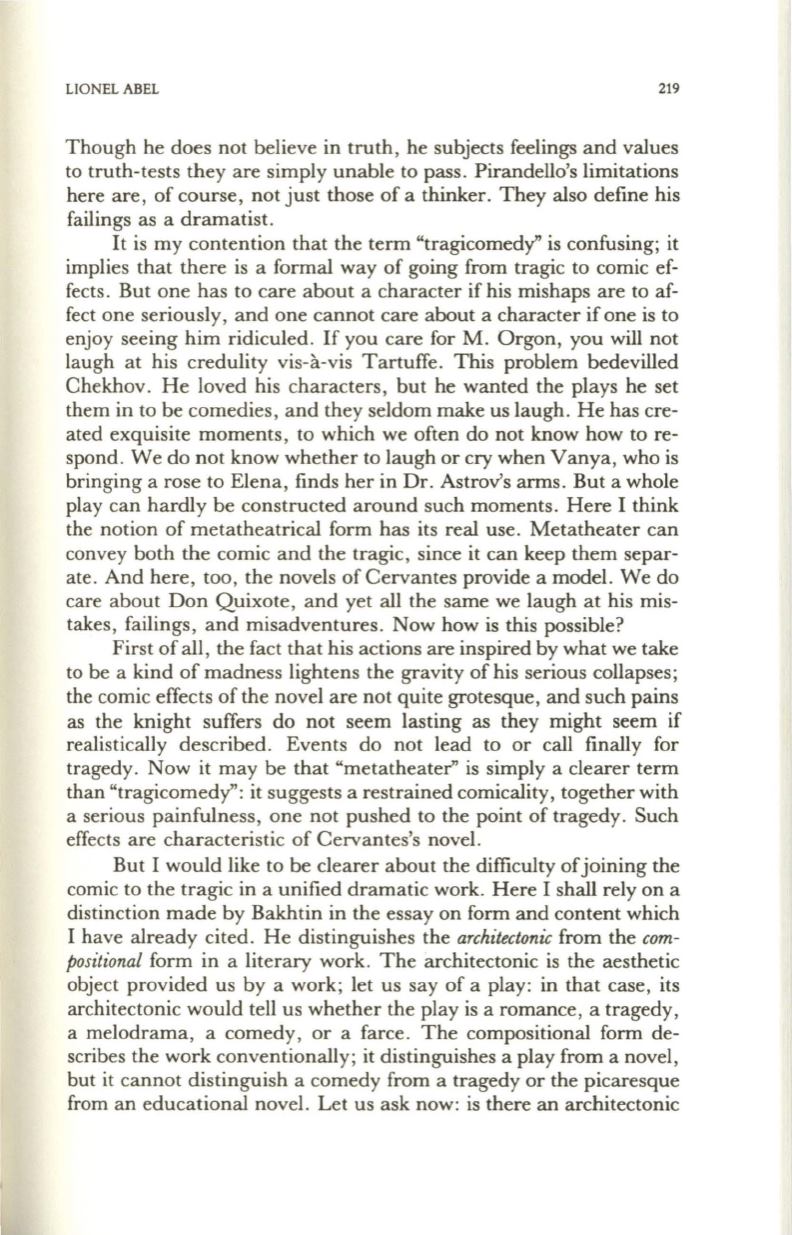
LIONEL ABEL
219
Though he does not believe in truth, he subjects feelings and values
to truth-tests they are simply unable to pass. Pirandello's limitations
here are, of course , not just those of a thinker. They also define his
failings as a dramatist.
It
is my contention that the term "tragicomedy" is confusing; it
implies that there is a formal way of going from tragic to comic ef–
fects . But one has to care about a character if his mishaps are to af–
fect one seriously, and one cannot care about a character if one is to
enjoy seeing him ridiculed .
If
you care for M . Orgon, you will not
laugh at his credulity vis-a.-vis Tartuffe . This problem bedevilled
Chekhov . He loved his characters, but he wanted the plays he set
them in to be comedies , and they seldom make us laugh. He has cre–
ated exquisite moments, to which we often do not know how to re–
spond. We do not know whether to laugh or cry when Vanya, who is
bringing a rose to Elena, finds her in Dr. Astroy's arms. But a whole
play can hardly be constructed around such moments. Here I think
the notion of metatheatrical form has its real use . Metatheater can
convey both the comic and the tragic , since it can keep them separ–
ate . And here, too, the novels of Cervantes provide a model. We do
care about Don Quixote , and yet all the same we laugh at his mis–
takes, failings , and misadventures . Now how is this possible?
First of all , the fact that his actions are inspired by what we take
to be a kind of madness lightens the gravity of his serious collapses ;
the comic effects of the novel are not quite grotesque, and such pains
as the knight suffers do not seem lasting as they might seem if
realistically described . Events do not lead to or call finally for
tragedy. Now it may be that "metatheater" is simply a clearer term
than "tragicomedy" : it suggests a restrained comicality, together with
a serious painfulness , one not pushed to the point of tragedy. Such
effects are characteristic of Cervantes's novel.
But I would like to be clearer about the difficulty ofjoining the
comic to the tragic in a unified dramatic work. Here I shall rely on a
distinction made by Bakhtin in the essay on form and content which
I have already cited . He distinguishes the
architectonic
from the
com–
positional
form in a literary work . The architectonic is the aesthetic
object provided us by a work; let us say of a play: in that case , its
architectonic would tell us whether the play is a romance, a tragedy,
a melodrama, a comedy, or a farce. The compositional form de–
scribes the work conventionally; it distinguishes a play from a novel,
but it cannot distinguish a comedy from a tragedy or the picaresque
from an educational novel. Let us ask now: is there an architectonic


